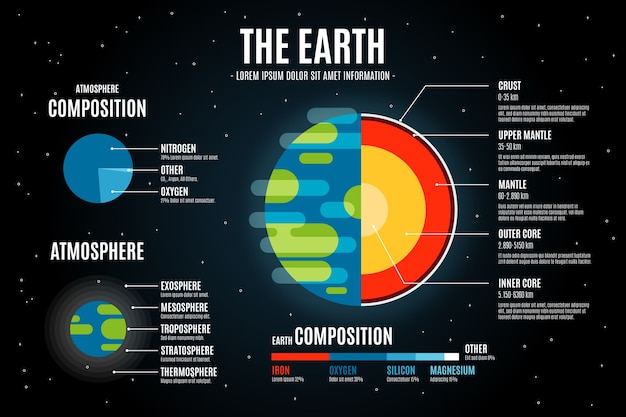Fascinating Facts about the Earth’s Atmosphere

The Earth’s atmosphere is made up of a mixture of gases.
The atmosphere is divided into five different layers: troposphere, stratosphere, mesosphere, thermosphere, and exosphere.
The atmosphere plays a crucial role in regulating the Earth’s temperature.
The ozone layer, located in the stratosphere, helps protect the Earth from harmful ultraviolet radiation.
The atmosphere contains approximately 78% nitrogen and 21% oxygen.
Carbon dioxide is another important gas present in the atmosphere, contributing to the greenhouse effect.
The Earth’s atmosphere extends about 6,200 miles (10,000 kilometers) above sea level.
The higher you go in the atmosphere, the colder the temperature becomes.
The atmosphere acts as a protective shield, shielding the Earth from space debris.
The atmosphere allows the Earth’s weather patterns to form and change.
The atmosphere contains water vapor, which is essential for cloud formation and precipitation.
The Earth’s atmosphere is not uniform; it is always changing and adapting to different conditions.
Pollution and human activities can negatively impact the atmosphere and its health.
Volcanic eruptions can release large amounts of gases and particles into the atmosphere, affecting weather patterns.
The atmosphere helps distribute heat from the Equator to the poles, creating global climate patterns.
The atmosphere contains layers of varying density, allowing birds and airplanes to fly.
Fascinating Facts about the Earth’s Atmosphere part 2
The atmosphere becomes thinner at higher altitudes, making it harder to breathe.
The temperature of the atmosphere can vary greatly depending on location and time of day.
The atmosphere has been evolving for billions of years, adapting to different conditions on Earth.
Extreme weather events, such as hurricanes and tornadoes, are influenced by the atmosphere.
The atmosphere filters out harmful cosmic rays from reaching the Earth’s surface.
The atmosphere helps retain heat during the night, preventing extreme temperature changes.
Climate change is directly linked to changes in the Earth’s atmosphere.
The atmosphere contains tiny suspended particles, known as aerosols, which can impact health and air quality.
The atmosphere’s composition can vary with altitude, causing unique atmospheric phenomena like auroras.
The atmosphere protects life on Earth by absorbing and scattering the Sun’s harmful radiation.
The atmosphere’s lower layers are denser, allowing sound waves to travel and produce audible sounds.
The atmosphere’s density decreases with height, leading to reduced air pressure at higher altitudes.
The atmosphere’s composition affects the color of the sky; blue during the day and red during sunsets.
The atmosphere can trap pollutants and create stagnant air conditions, leading to poor air quality.
The atmosphere’s moisture content influences the formation of dew, fog, and clouds.
The composition of the atmosphere on other planets can greatly differ from Earth’s.
The atmosphere helps distribute nutrients and gases necessary for the survival of plants and animals.
The atmosphere’s greenhouse effect is crucial for maintaining a livable temperature on Earth.
The atmosphere’s density decreases exponentially with increasing altitude.
The atmosphere can produce beautiful optical phenomena, such as rainbows and halos.
The atmosphere’s pressure decreases with altitude, making it more challenging to breathe on mountaintops.
The atmosphere’s layers protect satellites in orbit from being damaged by space debris.
The atmosphere’s circulation patterns, such as trade winds and jet streams, drive weather systems.
The atmosphere’s ozone layer is gradually recovering thanks to international efforts to reduce ozone-depleting substances.
The atmosphere is a vast reservoir of gases that constantly interact with the Earth’s surface.
The atmosphere’s role in regulating temperature prevents extreme temperature swings between day and night.
The atmosphere acts as a buffer, absorbing and reducing the impact of meteoroids before reaching the ground.
The atmosphere’s composition has evolved over time due to biological and geological processes.
The atmosphere’s upper layers contain plasma, allowing for the formation of brilliant auroras at high latitudes.